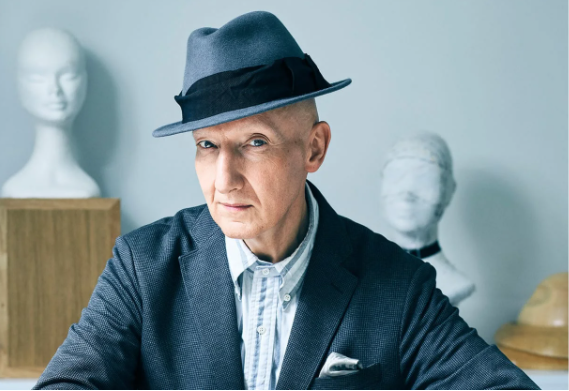Reconnect with your clothes, says model Rachel Rutt on this week’s episode. We live in a our throwaway society. "Landfill fashion" has become a phrase - we literally buy clothes to throw them away. With fast fashion brands dropping new stock into store sometimes as often as every week, we're consuming new clothes like never before. The average woman wears just 40 % of what's in her wardrobe, meanwhile it's cool to declutter. Or is it? Have you considered where all that "clutter" ends up when you remove it from your house? Rachel makes the case for making mending great again!
Ep 14 LINDA JACKSON, REINVENTING AUSTRALIAN FASHION
Iconic Aussie fashion designer Linda Jackson, along with her friend Jenny Kee, invented a new language for modern Australian fashion in the 1970s, with their boutique Flamingo Park.
This Episode is about friendship, culture and respect, and valuing originality. It’s also broadly about craft and technique and the hands-on practice of making clothes. And it's about contemporary Australian fashion history, and some of the important creative voices that shared it.
Ep 13 STEPHEN JONES, FROM CLUB KID TO CHRISTIAN DIOR
Ep 12 BARNEY'S WINDOW DRESSER SIMON DOONAN'S EXTRAORDINARY FASHION LIFE
Be yourself, everybody else is taken. Growing up gay and dreaming of glamour in 1960s Reading, he moved to Manchester then London in search of what he calls “the beautiful people”, cadging window dressing jobs off the likes Tommy Nutter (tailor to the Beatles and the Rolling Stones) and cult filmmaker Ken Russell’s wife along the way. In La La Land, he did the windows for luxury boutique Maxfield. In mid-80s Manhattan, he worked for Diana Vreeland at the Met, before joining Barneys.
Simon’s story is both extraordinary, and, in a weird way, ordinary – in that Fashion Land has long been a place where eccentric, creative kids from small unremarkable towns can find a home and thrive.
In this Episode we talk about his professional path, and how today’s new generation of designers and dream weavers can navigate the changed fashion landscape. We discuss Simon’s unwavering belief in the value of originality ("Conformity is the only real fashion crime") and some of the fashion geniuses he’s encountered. And of course we TALK SHOP…
Ep 11 CONSCIOUS CHATTER'S KESTREL JENKINS, CURIOSITY COUNTS
By the power of the podcast. An insightful interview with Conscious Chatter founder Kestrel Jenkins, we discuss the power of the podcast as a medium, who we think is listening and why, and how we keep them tuned in.
We share our perspectives on ethical and sustainable fashion, discuss how the conversation has changed since we both first joined it, and where we see it heading.
Ep 10 STYLIST MEGAN MORTON, CHASING DREAMS, FINDING BEAUTY
We thought it was about time we talked about beauty. Beauty is one of the major motivators for people who work in creative industries – they want to make beautiful things, whether it’s a garment, textile, show or picture. They want, as Megan Morton puts it: to capture beauty, to try to understand it.
Megan is a stylist, author and “house whisperer” with a life-long love for vintage and the stories behind old things. She grew up on a banana farm in Queensland, where her mum subscribed to 1970s back-to-the-land magazine, Grass Roots. Megan was raised to see the beauty in nature, while figuring out how to make stuff.
Today her styling work is focused on houses and interiors, but she turns her eye for beauty on everything from her wardrobe, to teaching to travel to Instagram. She’s worked for magazines like Vogue Living and Elle Decoration, and is the author of four books.
Ep 9 THE STORY OF SLUMWEAR & THE POSSIBILITY PROJECT
What do you think is possible? How about impossible? Kim Pearce and Katherine Davis are living proof of the old adage: where there’s a will there’s a way. The Possibility Project which they cofounded after meeting on the school run, “delivers social justice programs through the mindset of social entrepreneurship”.
This is a conversation about female friendship, social enterprise and fulfilling your potential.
Ep 8 STYLELIKEU'S ELISA GOODKIND, REDEFINING BEAUTY
STYLE LIKE U IS A PLATFORM CREATED TO CHALLENGE THE OUTDATED OLD RUBBISH ABOUT WHAT’S BEAUTIFUL AND WHAT’S NOT STILL SPRUIKED BY GLOSSY MAGS.
Founders Elisa Goodkind and her daughter Lily Mandelbaum want us to take back our power from mags, advertisers and the global fashion business, so that getting dressed each day becomes an act of self-love. Here's to a more inclusive future.
Ep 7 MARINA DEBRIS, THE GROTESQUE BEAUTY OF TRASHION
OCEAN PLASTIC IS A NIGHTMARE - BUT SOMEONE’S GOT TO SOLVE IT. MEET MARINA DEBRIS - TRASHION ACTIVIST. American visual artist Marina DeBris calls herself a TRASHION designer, as well as an environmental activist, and anti-plastics campaigner. She makes her "Beach Couture" collections from rubbish she finds washed up on the beaches of Los Angeles and Sydney.
There’s a history of fashion designers referencing rubbish. John Galliano's controversial Spring 2000 haute couture collection for Christian Dior featured newspaper prints inspired by the homeless people he used to jog past along the Seine river in Paris.
Ep 5 UNION LEADER KALPONA AKTER, BEYOND RANA PLAZA
80 % of GARMENT WORKERS ARE WOMEN, most aged between 18 and 25. Most have children and aren't paid nearly enough for their toils. In this powerful Episode, Kalpona Akter - executive director of the Bangladesh Centre for Worker Solidarity (BCWS), self-professed NOISY WOMAN, and former child labourer who began working in a garment factory at age 12 - tells her extraordinary story.
It includes dark tales of murder and danger as well as stories of resilience and hope. She explains what it’s really like for female garment workers in Bangladesh, and gives her first-hand account of the aftermath of RANA PLAZA. She shares her insights into what we, as consumers, can do. And it doesn't involve boycotting 'Made in Bangladesh'.















